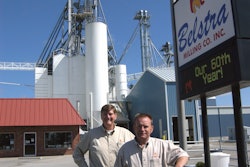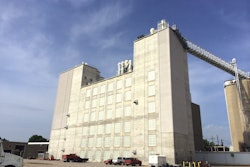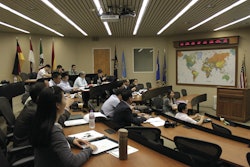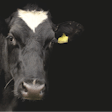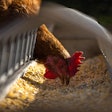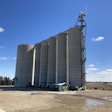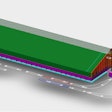Butterball is synonymous with turkey; however, in the instance of its new feed mill, it's happenstance that brought U.S.’s largest vertically integrated turkey producer to Turkey, NC.
The Turkey facility was originally intended to operate as a hog mash mill; however, a downturned economy forced Coharry Farms to put its new-yet-vacant mill up for sale. Meanwhile, in 2010, Seaboard Corporation acquired a 50% ownership of Butterball LLC from Smithfield Foods; Goldsboro Milling Company, a Goldsboro, NC-based turkey and hog producer, has held the other 50% since 2006. The new partnership prompted the decision to open a facility to feed the turkeys in Butterball's southern division. Though the company has feed mills and operations throughout the South, Butterball’s tom production is centralized in North Carolina, which, unfortunately for feed manufacturers, is an ingredient deficient area.
With the high costs associated with trucking in raw ingredients, a facility with rail access was a high priority. Thirty-five miles down the road from Goldsboro headquarters, the folks in the Goldsboro feed division were familiar with the site and its valuable location on the Carolina Southern Railway Company (CSX) rail line.
“In December 2010, Butterball purchased the mill and contracted WL Port-Land to add storage, steam and pelleting in addition to a rail expansion,” explains Lorenz Falls, Goldsboro’s feed division manager. "This was fast-track project — our plan was to be up and running in August."
Mill manager Terry Mercer, who joined Butterball the second week of June 2011, recalls his first week on the job: “When I came on board we were still in the process of getting [the equipment] installed; construction was underway; and the permits were still pending.” In addition to finalizing the entire project, he says, the mill had to hire and train a group of green employees.
Thought there were challenges along the way, the renovation was completed ahead of schedule, a feat Falls attributes to a “fantastic relationship” with WL Port-Land.
“In the end, our operational ability outpaced our ability to have staff in place,” Mercer jokes. “We were ready to go, but we didn’t have anybody to work it. Our advice to companies trying to make a tight deadline: Don’t forget to get your staff hired so you have enough time to get everyone properly trained before it is go-time.”
Butterball operates five feed mills in three states: North Carolina, Kansas and Arkansas.
An Ambitious Rail Expansion
From the beginning, the Butterball team knew the rail expansion was going to be a trying undertaking, but one that would provide the site with substantial saving on freight and railcar unloading. The site, built in 2006, was only meant to accommodate 65-car unit grain trains; today, CSX only accepts 90-car trains. In addition to space constraints, the accommodation of longer trains poses the challenge of a tightening radius, making it difficult to meet the CSX's specifications for a curved ladder track. Eventually, the site was able to meet CSX’s specifications for a 12-degree curvature.
“CSX engineers helped to design the track to fit within our property boundaries,” Falls explains. ”We had to layout the track two or three times before we received approval. Overall, the track building took the most time and effort.”
Once the track was laid, Butterball had three rail car moving options: CSX offers a locomotive rental program, but it requires employees be send to CSX school and there is a fee every time the locomotive is rented; Butterball could lease a switch engine and pay the fuel costs; or it could buy a Shuttlewagon mobile railcar mover.
Butterball chose to purchase an oversized Shuttlewagon. Falls explains : “Look at fuels cost vs. what the Shuttlewagon burns – and when you look at all three the Shuttlewagon was the best option. It’s a high capital investment initially, but the cost to operate is much better than the other two options.”
Though Butterball purchases as much local grain as the two grain seasons — wheat in June and corn in September — will allow; the company ships the balance of its grain needs on unit trains from Ohio and Indiana. The facility anticipates receiving grain trains every other week, beginning in early December.
The company also added additional storage to handle the volume of raw ingredients the 90-car unit trains will be delivering.
“We needed to expand the facility’s 250,000 storage capacity to be able to hold the 340,000 bushels per train that we need unloaded in a 24-hour window,” Falls explains. As part of its storage expansion, Butterball added two new 250,000-bushel Brock grain bins.
In addition to its grain receiving, Butterball paid significant attention to its liquid rail receiving.
“The amount of fat the facility uses influenced the decision to make this investment,” Falls explains. “With nine feed mills in the area, truck fat availability can be tight in this area. Butterball’s purchasing looked at options to get fat pulled in from different geographic areas, and discovered would be cheaper through rail rather than relying on trucking.”
The company installed a rail fat unloading station tied to the storage tanks via underground drainage line, as Mercer explains, “because we didn’t have room to run overhead lines.” Fat tanker cars pump the steam-treated fat through lines encased in cement under the driveway to tanks next to the mill. The site has 240 tons of fat storage.
“The direct delivery of fat to the storage area is the most efficient and provides a minimal chance for contamination,” he says
From Mash to Pellets
Falls, a veteran of the feed industry, drew on his expertise to head up the transformation of this one-time mash mill by streamlining its manufacturing efficiency and profitability. He selected Repete, an automation system he has had success with in the past, as the control system for all plant operations from receiving to loadout.
“Today's cost of ingredients dictates the use of a reliable control system," he notes.
麦芽浆厂的布局才离开房间pelleting equipment so WL Port-Land offered up this solution: construct a four story, structural steel pelleting annex, housing two complete pellet lines with direct access to the existing mill structure for efficient operation.
“What was unique about this situation was that they were able to build on to the side of the mill and put all the pelleting equipment in a structure outside the initial tower and bring it back into the mill,” Falls says. “It has worked very well.”
Butterball chose to run oversized pellet mills to ensure pellet quality, but also to deliver on labor savings. Falls explains: “[The oversized pellet mills] provide the capacity to produce the tons per hour vs. the labor cost to be more efficient. If you have two people in control room and you’re running smaller batches — say 20 tons/hour vs. oversized 40 tons/hour — the cost per ton is less because through put is higher with same amount of labor.”
Thirteen full-time employees run the mill working two shifts, five days a week.
The manufacturing process begins as the raw ingredients are fed CPM hammer mill to make the mash feed. Based on the formulas, Repete automation batches the feed at the ratio of the ingredients needed and is held in 24 ingredient storage bins in the mill with a volume of 93,240 cubic feet; microingredients are added through totes or XXX microbins. The ingredients move to scales above the Scott mixer before heading to one of four mash storage bins with a total capacity of 180 tons.
Once in the pelleting line, the mash is conditioned with steam in an Andritz conditioner, and then sent to the CPM 90 X 42 pellet mills pelleting 60 tons/hour. The pellets, conditioned at 190 F, are fed stream from the Cleaver Brooks 500 hp boiler with a 30,000 pound/hour deareator housed in a separate boiler building.
For cooling, the pellets move to the Bliss Counterflow Coolers; Mercer notes that the round Bliss coolers make it easier to manage the consistency of the product because you’re “not fighting the corners.” One of the pellet lines has a Bliss Crumbler; the other is a straight line. Downstream fat application is provided by a Hayes & Stolz fat coater. The finished pellets are then delivered to feed storage or to the 18 truck load out bins.
Butterball delivers 20 different formulations — feeding toms from the brooder house to the finishing floor — to the 130 turkey producers it serves within a 50-mile radius of the facility. It contracts its feed hauling through Pinske Logistics, and utilizes 17 drivers and eight delivery units. By contracting its trucking services, the mill saves on equipment and upkeep.
Being very concerned with bio-security, Goldboro and Butterball take every precaution to keep its birds healthy. The Turkey facility installed a truck disinfectant station in an effort to keep disease out of the turkeys and allows us to avoid using expensive medicines to treat the birds.
“The system is custom designed by Goldsboro so we have standardized equipment and use,” he says. “Our veterinarian was instrumental in choosing the products and application in the disinfectant process; we used that design to put our system together.
Operating at full capacity it will produce 7,500 tons a week, 390,000 tons annually.
Will the lessons learned at the Turkey feed mill will be replicated elsewhere in the turkey empire? “Most definitely. We’re watching what we’re learning here so we can apply it at locations in the future,” Falls says.






